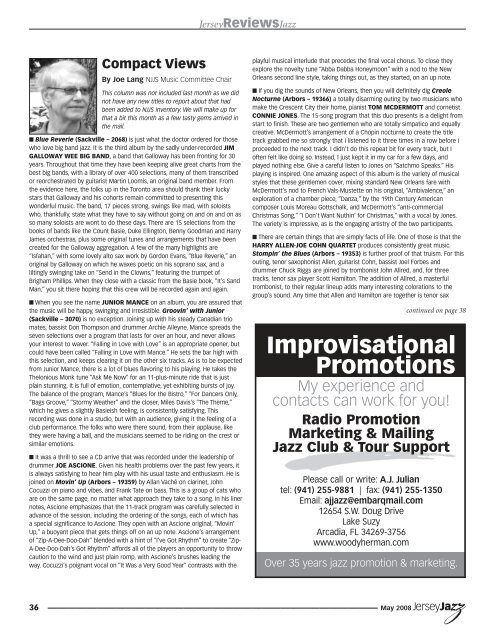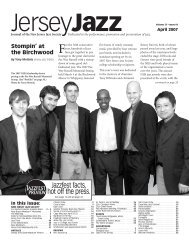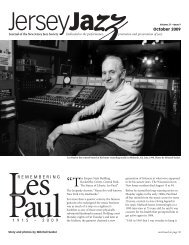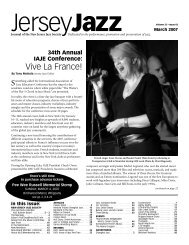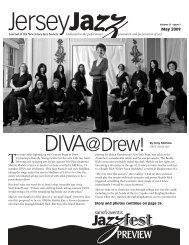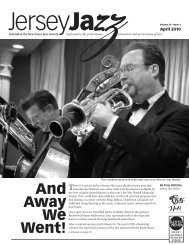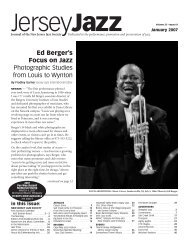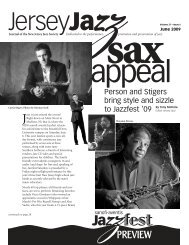Like John Coltrane, James L. Dean got some of his first experience
Like John Coltrane, James L. Dean got some of his first experience
Like John Coltrane, James L. Dean got some of his first experience
Create successful ePaper yourself
Turn your PDF publications into a flip-book with our unique Google optimized e-Paper software.
JerseyReviewsJazzCompact ViewsBy Joe Lang NJJS Music Committee ChairT<strong>his</strong> column was not included last month as we didnot have any new titles to report about that hadbeen added to NJJS inventory. We will make up forthat a bit t<strong>his</strong> month as a few tasty gems arrived inthe mail.■ Blue Reverie (Sackville – 2068) is just what the doctor ordered for thosewho love big band jazz. It is the third album by the sadly under-recorded JIMGALLOWAY WEE BIG BAND, a band that Galloway has been fronting for 30years. Throughout that time they have been keeping alive great charts from thebest big bands, with a library <strong>of</strong> over 400 selections, many <strong>of</strong> them transcribedor reorchestrated by guitarist Martin Loomis, an original band member. Fromthe evidence here, the folks up in the Toronto area should thank their luckystars that Galloway and <strong>his</strong> cohorts remain committed to presenting t<strong>his</strong>wonderful music. The band, 17 pieces strong, swings like mad, with soloistswho, thankfully, state what they have to say without going on and on and on asso many soloists are wont to do these days. There are 15 selections from thebooks <strong>of</strong> bands like the Count Basie, Duke Ellington, Benny Goodman and Harry<strong>James</strong> orchestras, plus <strong>some</strong> original tunes and arrangements that have beencreated for the Galloway aggregation. A few <strong>of</strong> the many highlights are“Isfahan,” with <strong>some</strong> lovely alto sax work by Gordon Evans, “Blue Reverie,” anoriginal by Galloway on which he waxes poetic on <strong>his</strong> soprano sax, and aliltingly swinging take on “Send in the Clowns,” featuring the trumpet <strong>of</strong>Brigham Phillips. When they close with a classic from the Basie book, “It’s SandMan,” you sit there hoping that t<strong>his</strong> crew will be recorded again and again.■ When you see the name JUNIOR MANCE on an album, you are assured thatthe music will be happy, swinging and irresistible. Groovin’ with Junior(Sackville – 3070) is no exception. Joining up with <strong>his</strong> steady Canadian triomates, bassist Don Thompson and drummer Archie Alleyne, Mance spreads theseven selections over a program that lasts for over an hour, and never allowsyour interest to waver. “Falling in Love with Love” is an appropriate opener, butcould have been called “Falling in Love with Mance.” He sets the bar high witht<strong>his</strong> selection, and keeps clearing it on the other six tracks. As is to be expectedfrom Junior Mance, there is a lot <strong>of</strong> blues flavoring to <strong>his</strong> playing. He takes theThelonious Monk tune “Ask Me Now” for an 11-plus-minute ride that is justplain stunning. It is full <strong>of</strong> emotion, contemplative, yet exhibiting bursts <strong>of</strong> joy.The balance <strong>of</strong> the program, Mance’s “Blues for the Bistro,” “For Dancers Only,“Bags Groove,” “Stormy Weather” and the closer, Miles Davis’s “The Theme,”which he gives a slightly Basieish feeling, is consistently satisfying. T<strong>his</strong>recording was done in a studio, but with an audience, giving it the feeling <strong>of</strong> aclub performance. The folks who were there sound, from their applause, likethey were having a ball, and the musicians seemed to be riding on the crest orsimilar emotions.■ It was a thrill to see a CD arrive that was recorded under the leadership <strong>of</strong>drummer JOE ASCIONE. Given <strong>his</strong> health problems over the past few years, itis always satisfying to hear him play with <strong>his</strong> usual taste and enthusiasm. He isjoined on Movin’ Up (Arbors – 19359) by Allan Vaché on clarinet, <strong>John</strong>Cocuzzi on piano and vibes, and Frank Tate on bass. T<strong>his</strong> is a group <strong>of</strong> cats whoare on the same page, no matter what approach they take to a song. In <strong>his</strong> linernotes, Ascione emphasizes that the 11-track program was carefully selected inadvance <strong>of</strong> the session, including the ordering <strong>of</strong> the songs, each <strong>of</strong> which hasa special significance to Ascione. They open with an Ascione original, “Movin’Up,” a buoyant piece that gets things <strong>of</strong>f on an up note. Ascione’s arrangement<strong>of</strong> “Zip-A-Dee-Doo-Dah” blended with a hint <strong>of</strong> “I’ve Got Rhythm” to create “Zip-A-Dee-Doo-Dah’s Got Rhythm” affords all <strong>of</strong> the players an opportunity to throwcaution to the wind and just plain romp, with Ascione’s brushes leading theway. Cocuzzi’s poignant vocal on “It Was a Very Good Year” contrasts with theplayful musical interlude that precedes the final vocal chorus. To close theyexplore the novelty tune “Abba Dabba Honeymoon” with a nod to the NewOrleans second line style, taking things out, as they started, on an up note.■ If you dig the sounds <strong>of</strong> New Orleans, then you will definitely dig CreoleNocturne (Arbors – 19366) a totally disarming outing by two musicians whomake the Crescent City their home, pianist TOM MCDERMOTT and cornetistCONNIE JONES. The 15-song program that t<strong>his</strong> duo presents is a delight fromstart to finish. These are two gentlemen who are totally simpatico and equallycreative. McDermott’s arrangement <strong>of</strong> a Chopin nocturne to create the titletrack grabbed me so strongly that I listened to it three times in a row before Iproceeded to the next track. I didn’t do t<strong>his</strong> repeat bit for every track, but I<strong>of</strong>ten felt like doing so. Instead, I just kept it in my car for a few days, andplayed nothing else. Give a careful listen to Jones on “Satchmo Speaks.” Hisplaying is inspired. One amazing aspect <strong>of</strong> t<strong>his</strong> album is the variety <strong>of</strong> musicalstyles that these gentlemen cover, mixing standard New Orleans fare withMcDermott’s nod to French Vals-Mustette on <strong>his</strong> original, “Ambivalence,” anexploration <strong>of</strong> a chamber piece, “Danza,” by the 19th Century Americancomposer Louis Moreau Gottschalk, and McDermott’s “anti-commercialChristmas Song,” “I Don’t Want Nuthin’ for Christmas,” with a vocal by Jones.The variety is impressive, as is the engaging artistry <strong>of</strong> the two participants.■ There are certain things that are simply facts <strong>of</strong> life. One <strong>of</strong> those is that theHARRY ALLEN-JOE COHN QUARTET produces consistently great music.Stompin’ the Blues (Arbors – 19353) is further pro<strong>of</strong> <strong>of</strong> that truism. For t<strong>his</strong>outing, tenor saxophonist Allen, guitarist Cohn, bassist Joel Forbes anddrummer Chuck Riggs are joined by trombonist <strong>John</strong> Allred, and, for threetracks, tenor sax player Scott Hamilton. The addition <strong>of</strong> Allred, a masterfultrombonist, to their regular lineup adds many interesting colorations to thegroup’s sound. Any time that Allen and Hamilton are together is tenor saxcontinued on page 38ImprovisationalPromotionsMy <strong>experience</strong> andcontacts can work for you!Radio PromotionMarketing & MailingJazz Club & Tour SupportPlease call or write: A.J. Juliantel: (941) 255-9881 | fax: (941) 255-1350Email: ajjazz@embarqmail.com12654 S.W. Doug DriveLake SuzyArcadia, FL 34269-3756www.woodyherman.comOver 35 years jazz promotion & marketing.36__________________________________ May 2008


